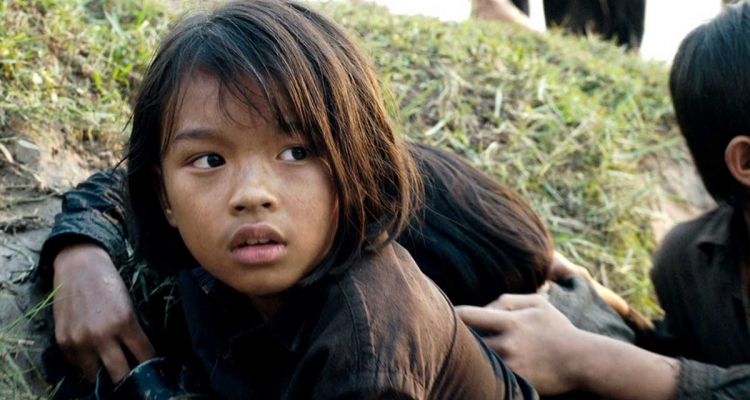TELLURIDE – As a five-year-old living in Phnom Penh, the capitol of Cambodia, Loung Ung was as happy any girl her age could be. She lived a relatively prosperous life thanks to her father’s position in the government and enjoyed the love and support of her older brothers and sisters. When the Khmer Rouge invaded the city and took over the country in 1975 her life – like the entire nation’s – changed forever. It’s a journey told through the eyes of a child in Angelina Jolie’s moving drama “First They Killed My Father” which debuted at the 2017 Telluride Film Festival and will be released on Netflix later this year.
Adapted from Ung’s 2000 non-fiction book, “Father” omits many of the details of Loung’s story (which took place over three years), but Jolie and Ung have fashioned a screenplay that gets at the heart of what she experienced. When the Khmer Rouge entered the capital there was hope from the people of a united Cambodia, especially after years of civil war. Instead, the Khmer Rouge army evacuated the city for what they said was just “three days.” Instead, Ung and her family, like thousands of others, found themselves pushed into the countryside to work in camps on behalf of “the Angkar” (the organization). The Khmer Rouge dismantled ever aspect of western life and modern culture in Cambodia by force or death. The people who lived in the city previously were now meant to become “old” Cambodians working in the rice fields.
Loung’s father (Kompheak Phoeung, very good) worked in the government, but quickly realizes what the Khmer Rouge are up to. As they flee their home he removes any semblance of his past life that he can in hopes of keeping their family together. After a few days on the roads in the countryside they are found by Loung’s uncle who has spent days searching for them. He invites them to stay with his family. This leads to a short respite for Loung and her brothers and sisters. She can play with her cousins and is enraptured the beauty of their life in the countryside. Stability doesn’t last long, however, and Loung’s family is forced to leave after the nearby villagers – swept up in the Khmer Rouge movement – vote them out.
Eventually, Loung’s family, along with other exiles, are picked up by soldiers and dropped off at a work camp. While her mother and father are sent out to the fields to grow rice, Loung is indoctrinated in the new propaganda of the new regime and pick vegetables. When it’s decided she’s strong enough she’s sent to work in the fields as well. Eventually the family is split up and Loung begins a remarkable odyssey that is uniquely inspiring and, at times, a triumph of the human spirit (yes, that’s not an exaggeration).
As you might guess, “First” would not work without the right actress playing Loung and Jolie found the perfect muse in youngster Sreymoch Sareum. Sareum’s eyes marvelously echo the horror often occurring around her in ways Jolie couldn’t have possibly imagined. The director also uses a motif of extreme close ups on her face with numerous “events” still visible slightly behind her so the viewer can truly contemplate the enormity of what’s going on in the context of such a seemingly delicate creature. If not for Sareum’s charismatic performance the film might fold like a house of cards.
Notably, when there is dialogue it’s completely in Khmer, the language of Cambodia. While there are significant speaking roles, long stretches of the film are almost completely silent except for the sounds of a forest, exploding bombs or workers in a paddy field. Jolie has already spoken about how she’s only been a “vessel” to tell this story, but that humble observation diminishes how impressive her filmmaking skills are.
Since her directorial debut, “In the Land of Blood and Honey,” Jolie has demonstrated a wonderfully talented eye, but here she collaborates with cinematographer Anthony Dod Mantle to breathtaking effect. She’s telling a story that’s not in her native language (or one significant viewers would comprehend) and in many ways she’s actually making a silent film, having to use the cinematic technique to tell her story. There is no stream of exposition to help divulge a plot point or explain a situation. The camera has to tell the tale.
If a man had directed this film he’d already be heralded as the next cinematic auteur, a master craftsman of the medium. Jolie might not want the spotlight to distract from the atrocities she’s bringing to moviegoers attention on the screen, but as a filmmaker she deserves that same high praise and the same accolades. In fact, we demand it. [A-]


